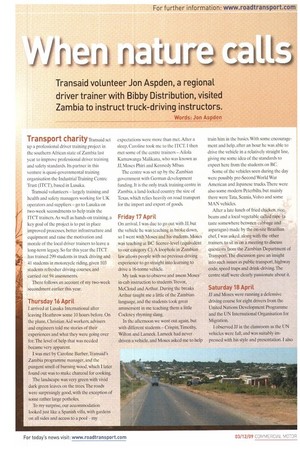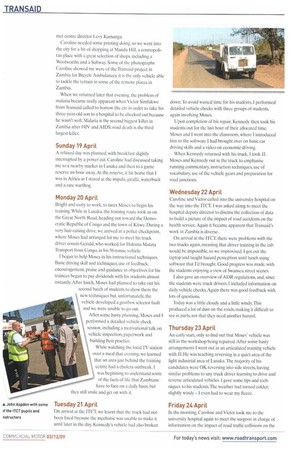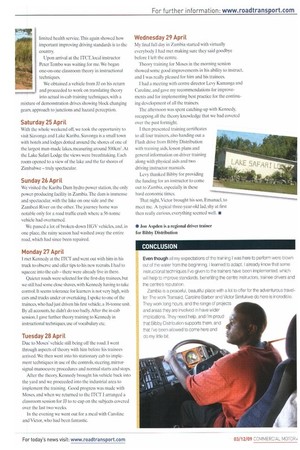Transaid volunteer Jon Aspden, a regional.
Page 45

Page 46

Page 47

If you've noticed an error in this article please click here to report it so we can fix it.
driver trainer with Bibby Distribution, visited Zambia to instruct truck-driving instructors.
Words: Jon Aspden
Transport charity Transaid set up a professional driver training project in the southern African state of Zambia last year to improve professional driver training and safety standards Its partner in this venture is quasi-governmental training organisation the Industrial Tiaining Centre Trust (ITCT), based in Lusaka.
Transaid volunteers — largely training and health and safety managers working for UK operators and suppliers — go to Lusaka on two-week secondments to help train the ITCT trainers. As well as hands-on training, a key goal of the project is to put in place improved processes, better infrastructure and equipment and raise the motivation and morale of the local driver trainers to leave a long-term legacy. So far this year the ITCT has trained 299 students in truck driving and 41 students in motorcycle riding, given 103 students refresher driving courses, and carried out 94 assessments.
, There follows an account of my two-week 'secondment earlier this year.
Thursday 16 April
I arrived at Lusaka International after leaving Heathrow some 10 hours before. On the plane, Christian Aid workers, advisers and engineers told me stories of their experiences and what they were going over for. The level of help that was needed became very apparent.
I was met by Caroline Barber,Transaicl's Zambia programme manager, and the pungent smell of burning wood, which I later found out was to make charcoal for cooking.
The landscape was very green with vivid dark green leaves on the trees. The roads were surprisingly good, with the exception of some rather large potholes.
To my surprise, our accommodation looked just like a Spanish villa, with gardens on all sides and access to a pool my expectations were more than met. After a sleep, Caroline took me to the frcr. I then met some of the centre trainers — Ailola Kamuwanga Malikana, who was known as JJ, Moses Phiri and Kennedy Mbao.
The centre was set up by the Zambian government with German development funding. It is the only truck training centre in Zambia, a land-locked country the size of Texas, which relies heavily on road transport for the import and export of goods.
Friday 17 April
On arrival, I was due to go out with JJ, but the vehicle he was teaching in broke down, so I went with Moses and his students. Moses was teaching at BC licence-level (equivalent to our category C). A loophole in Zambian law allows people with no previous driving experience to go straight into learning to drive a 16-tonne vehicle.
My task was to observe and assess Moses' in-cab instruction to students Trevor. McCloud and Arthur. During the breaks Arthur taught me a little of the Zambian language, and the students took great amusement in me teaching them a little Cockney rhyming slang.
In the afternoon we went out again, but with different students — Crispin, Timothy, Wilton and Lameck. Lameck had never driven a vehicle, and Moses asked me to help train him in the basics With some encouragement and help, after an hour he was able to drive the vehicle in a relatively straight line, giving me some idea of the standards to expect here from the students on BC.
Some of the vehicles seen during the day were possibly pre-Second World War American and Japanese trucks.There were also some modern Peterbilts. but mainly there were Tata, Scania, Volvo and some MAN vehicles.
After a late lunch of fried chicken, rice, beans and a local vegetable called rape (a taste somewhere between cabbage and asparagus) made by the on-site Brazilian chef, I was asked, along with the other trainers, to sit in on a meeting to discuss questions from the Zambian Department of Transport:the discussion gave an insight into such issues as public transport, highway code, speed traps and drink-driving. The centre staff were clearly passionate about it.
Saturday 18 April
IT and Moses were running a defensive driving course for eight drivers from the United Nations Development Programme and the UN International Organisation for Migration.
I observed JJ in the classroom as the UN vehicles were full, and was suitably impressed with his style and presentation. I also met centre director Levy Kamanga.
Caroline needed some printing doing, so we went into the city for a bit of shopping at Manda Hill, a cosmopolitan place with a great selection of shops, including a Woolworths and a Subway. Some of the photographs Caroline showed me were of the Transaid project in Zambia for Bicycle Ambulances; it is the only vehicle able to tackle the terrain in some of the remote places in Zambia.
When we returned later that evening, the problem of malaria became really apparent when Victor Simfukvve from Transaid called to borrow the car in order to take his three-year-old son to a hospital to be checked out because he wasn't well. Malaria is the second biggest killer in Zambia after HIV and AIDS; road death is the third largest killer.
Sunday 19 April
A relaxed day was planned, with breakfast slightly interrupted by a power cut. Caroline had discussed taking me to a nearby market in Lusaka and then to a game reserve an hour away. At the reserve, it hit home that I was in Africa as I stared at the impala, giraffe, waterbuck and a rare warthog.
Monday 20 April
Bright and early to work, to meet Moses to begin his training. While in Lusaka, the training route took us on the Great North Road, heading out toward the Democratic Republic of Congo and the town of Kitwe. During a very hair-raising drive, we arrived at a police checkpoint, where Moses had arranged for me to meet his truck driver cousin Gerald, who worked for Hakuna Matata Transport from Congo, in his 56-tonne vehicle.
I began to help Moses in his instructional techniques. Basic driving skill and techniques, use of feedback, encouragement, praise and guidance in objectives for his trainees began to pay dividends with his students almost instantly. After lunch, Moses had planned to take out his second batch of students to show them the new techniques but, unfortunately, the vehicle developed a gearbox selector fault and we were unable to go out.
After some hasty planning, Moses and I performed a detailed vehicle check session, including a motivational talk on vehicle inspection, paperwork and building best practice.
While watching the local IV station over a meal that evening, we learned that an area just behind the training centre had a cholera outbreak. I was beginning to understand some of the facts of life that Zambians have to face on a daily basis, but they still smile and get on with it.
Tuesday 21 April
On arrival at the ITCT, we learnt that the truck had not been fixed because the mechanic was unable to make it until later in the day. Kennedy's vehicle had also broken down. lo avoid wasted time for his students, I performed detailed vehicle checks with three groups of students, again involving Moses.
Upon completion of his repair, Kennedy then took his students out for the last hour of their allocated time. Moses and I went into the classroom, where I introduced him to the software I had brought over on basic car driving skills and a video on economic driving.
When Kennedy returned with his truck. I took JJ, Moses and Kennedy out in the truck to emphasise running commentary, instruction techniques, use of vocabulary, use of the vehicle gears and preparation for road junctions.
Wednesday 22 April
Caroline and Victor called into the university hospital on the way into the ITCT. I was asked along to meet the hospital deputy director to discuss the collection of data to build a picture of the impact of road accidents on the health service. Again it became apparent that Transaid's work in Zambia is diverse.
On arrival at the ITCT. there were problems with the two trucks again, meaning that driver training in the cab would be impossible, so we improvised. I got out the laptop and taught hazard perception until lunch using software that I'd brought. Good progress was made, with the students enjoying a view of Swansea street scenes.
I also gave an overview of ADR regulations, and, since the students were truck drivers, I included information on daily vehicle checks. Again there was good feedback with lots of questions.
Today was a little cloudy and a little windy. This produced a lot of dust on the roads, making it difficult to see in parts, not that they need another hazard.
Thursday 23 April
An early start, only to find out that Moses' vehicle was still in the workshop being repaired. After some hasty arrangements I went out in an articulated training vehicle with JJ. He was teaching reversing in a quiet area of the light industrial area of Lusaka.The majority of his candidates were OK reversing into side streets, having similar problems to any truck driver learning to drive and reverse articulated vehicles. I gave some tips and techniques to his students. The weather had turned colder; slightly windy — I even had to wear my fleece.
Friday 24 April
In the morning, Caroline and Victor took me to the university hospital again to meet the surgeon in charge of information on the impact of road traffic collisions on the limited health service. This again showed how important improving driving standards is to the country.
Upon arrival at the ITCT, local instructor Peter Tembo was waiting for me. We began one-on-one classroom theory in instructional techniques.
We obtained a vehicle from .1.1 on his return and proceeded to work on translating theory into actual in-cab training techniques, with a mixture of demonstration drives showing block changing gears, approach to junctions and hazard perception.
Saturday 25 Aprit
With the whole weekend off, we took the opportunity to visit Siavonga and Lake Kariba. Siavonga is a small town with hotels and lodges dotted around the shores of one of the largest man-made lakes, measuring around 500km2. At the Lake Safari Lodge the views were breathtaking. Each room opened to a view of the lake and the far shores of Zimbabwe — truly spectacular.
Sunday 26 April
We visited the Kariba Dam hydro power station, the only power-producing facility in Zambia. The dam is immense and spectacular, with the lake on one side and the Zambezi River on the other. The journey home was notable only for a road traffic crash where a 56-tonne vehicle had overturned.
We passed a lot of broken-down HG V vehicles, and, in one place, the rainy season had washed away the entire road, which had since been repaired.
Monday 27 April
I met Kennedy at the ITCT and went out with him in his truck to observe and offer tips to his new recruits I had to squeeze into the cab— there were already five in there.
Quieter roads were selected for the first-day trainees, but we still had some close shaves, with Kennedy having to take control. It seems tolerance for learners is not very high, with cars and trucks under or overtaking. I spoke to one of the trainees, who had just driven his first vehicle, a 16-tonne unit. By all accounts, he didn't do too badly. After the in-cab session,! gave further theory training to Kennedy in instructional techniques, use of vocabulary etc.
Tuesday 28 April
Due to Moses' vehicle still being off the road, I went through aspects of theory with him before his trainees arrived. We then went into his stationary cab to implement techniques in use of the controls, steering, mirrorsignal-manoeuvre procedures and normal starts and stops.
After the theory, Kennedy brought his vehicle back into the yard and we proceeded into the industrial area to implement the training. Good progress was made with Moses, and when we returned to the ITCT I arranged a classroom session for JJ to re-cap on the subjects covered over the last two weeks.
In the evening we went out for a meal with Caroline and Victor, who had been fantastic.
Wednesday 29 Apra
My final full day in Zambia started with virtually
everybody I had met making sure they said goodbye before left the centre.
Theory training for Moses in the morning session
showed some good improvements in his ability to instruct, and I was really pleased for him and his trainees
I had a meeting with centre director Levy Kamanga and Caroline, and gave my recommendations for improve ments and for implementing best practice for the continuing development of all the trainers.
The afternoon was spent catching-up with Kennedy, recapping all the theory knowledge that we had covered over the past fortnight.
I then presented training certificates to all four trainers, also handing out a Flash drive from Bibby Distribution with training aids, lesson plans and general information on driver training along with physical aids and two driving instructor manuals.
Levy thanked Bibby for providing the funding for an instructor to come out to Zambia, especially in these hard economic times.
That night, Victor brought his son, Emanuel, to meet me. A typical three-year-old lad, shy at first then really curious, everything seemed well. • • Jon Aspden is a regional driver trainer for Bibby Distribution














































































































































